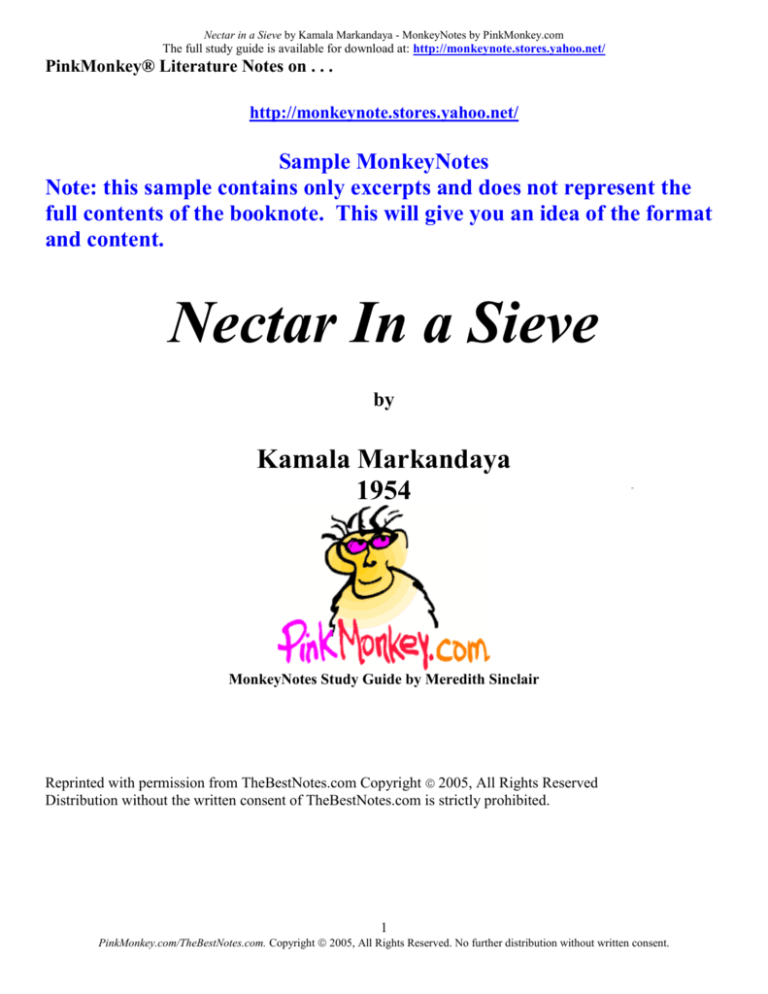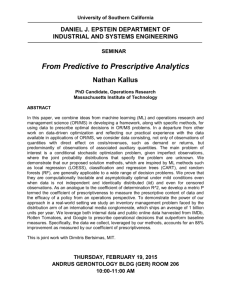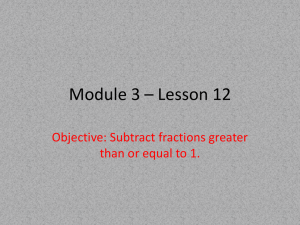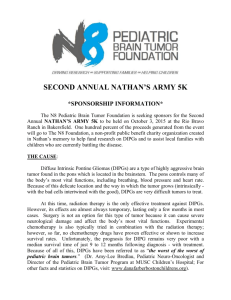
Nectar in a Sieve by Kamala Markandaya - MonkeyNotes by PinkMonkey.com
The full study guide is available for download at: http://monkeynote.stores.yahoo.net/
PinkMonkey® Literature Notes on . . .
http://monkeynote.stores.yahoo.net/
Sample MonkeyNotes
Note: this sample contains only excerpts and does not represent the
full contents of the booknote. This will give you an idea of the format
and content.
Nectar In a Sieve
by
Kamala Markandaya
1954
MonkeyNotes Study Guide by Meredith Sinclair
Reprinted with permission from TheBestNotes.com Copyright 2005, All Rights Reserved
Distribution without the written consent of TheBestNotes.com is strictly prohibited.
1
PinkMonkey.com/TheBestNotes.com. Copyright 2005, All Rights Reserved. No further distribution without written consent.
Nectar in a Sieve by Kamala Markandaya - MonkeyNotes by PinkMonkey.com
The full study guide is available for download at: http://monkeynote.stores.yahoo.net/
KEY LITERARY ELEMENTS
SETTING
Part I of the novel is set in an unnamed village in rural India. No date is given but the setting is probably some
time in the first half of the 20th century. The villagers live in simple mud huts with thatch roofs and are largely
subsistence farmers. The main crop and diet is rice supplemented with vegetables and …..
CHARACTER LIST
Major Characters
Ruku (Rukmani) - Ruku is the protagonist and narrator; we watch her mature from a nervous, young bride of
12 to a wise and thoughtful woman of old age. Although she faces many…..
Nathan - Ruku’s loving husband, Nathan is a constant in Ruku’s uncertain life. Quiet and……
Ira (Irawaddy) - Ruku and Nathan’s eldest child and oldest daughter, Ira is an obedient child who….
Selvam - Ruku and Nathan’s fifth son – Selvam decides that despite his father’s wishes he ……
Kenny (Kennington) - An English doctor who appears from time to time in Ruku’s village. When…..
Minor Characters
Puli - Puli is an orphan and a leper but he displays the same courage and joy for life that Ruku does…...
Kunthi - Kunthi is a village woman Ruku’s age whom, from the beginning, seems to bear Ruku a…..
Arjun - Ruku and Nathan’s oldest son – Arjun takes a job at the tannery and leads a strike of the …..
Thambi - Ruku and Nathan’s second son – Thambi joins his brother Arjun in working at the…..
Murugan - Ruku and Nathan’s third son – Murugan takes a job in the city as a servant. When ….
Raja - Ruku and Nathan’s fourth son – Raja also takes a job at the tannery. Weakened by hunger, he…..
Additional characters are outlined in the complete MonkeyNotes Study Guide.
CONFLICT
Protagonist - The protagonist of a story is the main character who traditionally undergoes some sort of change.
In this novel, the protagonist is Ruku, an Indian woman from a rural village who struggles to find and hold onto
joy in the midst of overwhelming tragedy and hardship. Ruku and her husband face flood and……
Antagonist - The antagonist of a story is the force that provides an obstacle for the protagonist. The antagonist
does not always have to be a single character or even a character at all. In this story, no one character serves as
the antagonist. Rather the forces of change and nature provide Ruku with hardships to…..
Climax - The climax of a plot is the major turning point that allows the protagonist to resolve the conflict. The
end of Part I brings the climax of the novel – after years of struggling against nature and the tannery, Ruku and
Nathan lose the battle and their land. Unable to pay the land dues, they are forced to leave…..
Outcome - The outcome, resolution, or denouement occurs when with their son Murugan gone and no way to
live in the city, Ruku and Nathan decide to return to the village. Before they can earn the….
2
PinkMonkey.com/TheBestNotes.com. Copyright 2005, All Rights Reserved. No further distribution without written consent.
Nectar in a Sieve by Kamala Markandaya - MonkeyNotes by PinkMonkey.com
The full study guide is available for download at: http://monkeynote.stores.yahoo.net/
SHORT PLOT / CHAPTER SUMMARY (Synopsis)
The novel is told as a flashback – an elderly Ruku recalls the many events of her life. She begins with her
wedding at 12 to a man she’d never met. Fortunately, her husband Nathan is a kind and gentle man who wants
to make a good life for his wife and family. Ruku and Nathan have a daughter, Ira, and then after several years
of infertility, 5 sons. Nathan hopes to some day own his land and provide a better life for his family, but as the
years go by that dream slips farther away. Life is hard but there is enough to eat and the family is happy.
Ruku’s quiet village is disrupted by the arrival of a tannery. She is unhappy about the changes, but Nathan
wisely advises her to learn to adapt so that she will not be broken. Ruku must soon face other changes as well;
Ira must be married and moves far away from her family.
The family’s crop of rice depends heavily on the rain; however, too much rain brings floods and destroys the
rice crop. For the first time, Ruku’s family faces severe hunger. Many turn to the tannery for work including
Ruku’s oldest sons, Arjun and Thambi.
Several years after her marriage, Ira returns to her family’s home. Her husband has rejected her as……
THEMES
The central themes of the novel are the power and importance of hope and the challenges of adapting to change.
Also important are the bonds of family, the conflicts between traditional life and modern life …….
MOOD
Because the story is told as a flashback, it has a reflective mood. Ruku is able to comment and analyze the
events of her life. Throughout the story, Ruku’s hope and continued perseverance in the face of …….
BACKGROUND INFORMATION - BIOGRAPHY
Kamala (Purnaiya) Taylor, who wrote under the pseudonym of Kamala Markandaya was born in the town of
Mysore in Southern India in 1924 to a Hindu-Brahmin (the highest Indian caste) family. In 1940, she went to
study history at the University of Madras. During this time, she also worked as a journalist and published short
stories in Indian newspapers. In 1948, Markandaya moved to England; she married Bertrand Taylor, an
Englishman, and made England her adopted home although she continued to visit her homeland regularly. The
couple had one daughter, Kim. Her husband died in 1986 and Markandaya died on May 16, 2004 at her home
outside London, England.
Markandaya first gained success with Nectar in a Sieve, although she had written two novels before it.
Published in 1954, the novel quickly became popular; it was a Book-of-the-Month Club main selection and …..
LITERARY / HISTORICAL INFORMATION
From the early 1800’s until 1947 India was a British colony. Under colonial rule, the Indians had little
authority and most remained poor and uneducated. Even today, many in India live in rural villages like the one
described in the novel.
Like Ruku and her family, most Indians practice Hinduism although there is a large Muslim minority. In the
Hindu faith there are many gods and goddesses – aside from Ruku and Nathan’s visit to the….
MEANING OF THE TITLE
The title comes from the poem “Work Without Hope” by Samuel Taylor Coleridge. The novel shows that hope
or the sweetness in life (nectar) can be difficult to hold on to – almost like trying to carry it ……
3
PinkMonkey.com/TheBestNotes.com. Copyright 2005, All Rights Reserved. No further distribution without written consent.
Nectar in a Sieve by Kamala Markandaya - MonkeyNotes by PinkMonkey.com
The full study guide is available for download at: http://monkeynote.stores.yahoo.net/
CHAPTER SUMMARIES AND NOTES/ANALYSIS
PART I
CHAPTER 1
Summary
The novel begins with Ruku (Rukmani), the narrator, as an old woman reflecting on her past. Ruku tells us that
she is now at peace although things have not always been so. After briefly mentioning those important to her
(her now dead husband, her son and daughter, Puli and Kenny), she begins to tell the story of her life.
As a young girl living in a rural Indian village, Ruku had big dreams of fancy wedding. Her three older sisters
had progressively less lavish weddings, and Ruku’s mother was left to wonder what would happen to her
youngest, Ruku, who would have little for a dowry. Ruku believed her father’s position as village headman
would secure her a husband; she is unsure how to feel when her older brother tells her the village headman is
now of little importance in Indian life. With no money for a dowry and little in the way of looks, Ruku’s
family is forced to marry her to a poor tenet farmer whom she has never met.
Only 12 on her wedding day, Ruku remembers feeling more afraid than overjoyed but hints that other nights of
her married life were pleasant and sweet. After the wedding ceremony, Ruku and her new husband travel by
bullock cart to her new home in his village. Afraid and uncertain about her future, Ruku throws up along the
way. Ashamed, she expects her new husband, Nathan, will reprimand her; instead, he comforts her and dries
her tears.
Ruku begins to feel more comfortable with her husband and soon falls asleep on the cart. Nathan wakes her
when they arrive at their new home – a small mud hut with a thatched roof. Used to her father’s house, Ruku
nearly collapses into tears again at the sight of the small hut; however, the hurt in her husband’s eyes causes her
to disguise her disappointment. Nathan brings in a handful of rice and promises that after a few good harvests
they will be able to afford better.
Ruku begins to settle into married life and sets about learning the domestic duties she expected to perform as a
wife. She recalls doing her washing in the river near the hut using washing powder given to her by her mother.
It is there she first meets several of the village women who will become important in her life: Kali, the plump
and boisterous wife of her neighbor; homely Janaki, wife of a shopkeeper; and Kunthi, a beautiful woman of
Ruku’s age who is expecting her first child.
Kali jokes that despite their young age both Kunthi and Ruku will be mothers soon. She also reveals to Ruku
that Nathan had built their hut with his own hands and had spent weeks excitedly preparing for her arrival.
Ruku treasures this knowledge and asks Nathan about it after they are married for a while. She tells him she is
proud to live in a house he built himself; he replies that she has grown much and is no longer a child.
Ruku remembers the first months of her married life as a time of joy and hope. Although her husband did not
own his land, they had hopes to buy it after a few good harvests. They have plenty to eat during this time as
well – rice, dhal, wheatcakes, vegetables, ghee, milk and sugar. Ruku enjoys going into the village and is
becoming friendly with those who live there. She finds the pregnant Kunthi to be different from the other
women – somewhat cold and distant. Village talk says Kunthi “married beneath her” and is bitter. They say the
same of Ruku but she feels that nowhere could one find a better husband.
Ruku recalls also her ignorance of the basics of running her household. She depends on Kali and Janaki to
teach her how to milk the goat and churn butter, to plant seeds and grow her garden and to mull rice. After
growing her first pumpkins from seeds, Ruku proudly shows them to Nathan who declares her “clever”. Full of
pride and a new confidence as a wife, Ruku continues to tend her garden. Life is good for the new couple.
4
PinkMonkey.com/TheBestNotes.com. Copyright 2005, All Rights Reserved. No further distribution without written consent.
Nectar in a Sieve by Kamala Markandaya - MonkeyNotes by PinkMonkey.com
The full study guide is available for download at: http://monkeynote.stores.yahoo.net/
Notes
Ruku tells the story in the novel through first person point of view. Aside from a few brief paragraphs, the
novel is told as a flashback – Ruku is recalling the many events of her life. Her opening statements foreshadow
some of the events to come: the death of her husband, her adoption of Puli who suffers from disease, and the
work of Kenny and her son Selvam in building a hospital. She also hints that her life was full of sufferings
although she has “no fears now”.
Her marriage at the age of 12 is not unusual nor is the fact that she did not know her husband. Child marriage
was very common in India and girls younger than Ruku often found themselves as brides. Marriages were
arranged by the parents of the bride and groom and often depended on the bride’s dowry. A dowry (which
might consist of money, land, livestock or other goods) was necessary to secure a husband. The larger the
dowry, the better the husband a family could get for their daughter. As she is the fourth daughter and is not a
great beauty, Ruku’s family is forced to settle on a poor farmer who owns no land of his own.
Ruku’s belief that her father’s position as headman will guarantee her the grand wedding of her dreams shows
her childish innocence about the truth of things. Her older brother tells her that the headman is no longer of
“consequence,” a sign of the changes in Indian society that will soon impact Ruku in drastic ways.
As a grown woman, Ruku realizes that she was too much of a child to appreciate her wedding night and hints
that the fear she felt on that day gave way to joy in her marriage later. Her biggest memories of the day were
her sense of confusion, her mother’s tears, and her nausea on the wagon ride to her new home. These indicate
that she was indeed a child and experiencing an understandable fear at leaving the only home she had known for
life with a perfect stranger. Not only would she be a day’s journey from her family, she will also be expected to
perform all the duties of a wife – her childhood must forever be put behind her.
Nathan, Ruku’s husband, proves to be a gentle companion from the start. Ruku comments that she only ever
called him “husband” as was fitting for a wife – she lived in a patriarchal society that expected women to
submit to their husband’s will. Ruku’s reaction to the poor, simple mud hut Nathan has built is one of revulsion
and shame. She cannot imagine living in such poor conditions but would not dare to shame her husband by
saying so. After she learns Nathan built the hut himself and eagerly awaited her arrival, she feels even more
ashamed of her reaction; now she feels pride because of his love for her.
We are also introduced to some of the village women who will play a role in Ruku’s life. Kali and Janaki, who
are older and experienced, help Ruku to learn her duties as a wife. The gossip, Kali, especially becomes a
surrogate mother to Ruku and helps her to adjust to her new life. Kunthi, a girl Ruku’s age, is already pregnant.
Ruku senses Kunthi is different and her unease around Kunthi foreshadows things to come.
At the close of the chapter, Ruku recalls the plenty and hope of her first months of marriage. They have much
to eat and Nathan believes they may soon afford a better home and land of their own. This too foreshadows
hardships to come as Ruku remembers that her belly was not always so full and her heart not always so full of
hope.
The pumpkin Ruku proudly presents to Nathan is treated with great reverence. Her pride in successfully growing….
OVERALL ANALYSES
CHARACTER ANALYSIS
Ruku (Rukmani) - Ruku is a poor, Indian village woman who serves as the novel’s protagonist and narrator.
She tells the story of her life from her days as a nervous young bride of 12 to her twilight years as an old
widow. Along the way she endures much: infertility, rumors about her morality, the …..
5
PinkMonkey.com/TheBestNotes.com. Copyright 2005, All Rights Reserved. No further distribution without written consent.
Nectar in a Sieve by Kamala Markandaya - MonkeyNotes by PinkMonkey.com
The full study guide is available for download at: http://monkeynote.stores.yahoo.net/
Nathan - Nathan is a poor tenant farmer and Ruku’s loving husband. His quiet and steady devotion to his wife
and children helps carry Ruku through difficult times. He dreams of owning his own land and providing a
better life for his family, but nature and society conspire to keep him deep in poverty. Like his ….
Ira (Irawaddy) - Ruku and Nathan’s eldest child and oldest daughter, Ira is an obedient and loving child. Ruku
marvels at her beauty, wondering how she and Nathan managed to produce such a lovely child. Ira makes a
good marriage because of her looks but is abandoned by her husband as a …..
Selvam - Ruku and Nathan’s fifth son and the only one who does not leave the village, Selvam grows into an
intelligent and caring young man. Selvam is offered the chance to surpass his mother’s teachings and work
with Kenny to build a hospital in the village and to receive medical training. His loyalty…..
Kenny (Kennington) - Kenny is an English doctor who appears from time to time in Ruku’s village. Ruku first
meets him at her mother’s deathbed and stands in awe of him for much of her life. When Ruku is unable to
conceive, Kenny helps her. Later, Kenny mentors Ruku’s youngest son, Selvam. Over the…..
PLOT STRUCTURE ANALYSIS
The novel is told in flashback – at the start, we meet Ruku as an elderly woman reflecting on the events of her
life. This structure allows Ruku not only to narrate her life experiences but also to analyze them, helping the
reader to see how she learned and grew from each event.
The novel is also divided into two parts: Part one covers the majority of Ruku’s married life; the much shorter
part two deals with Ruku and Nathan’s failed attempt to move to the city after losing their land and contains the
falling action of the novel.
The first chapters (Ch. 1-3) deal with Ruku’s transformation from an uncertain child bride to a confident young
wife and mother. These chapters are mostly without hardship – the family is poor but has enough to eat; Ruku
and Nathan begin to realize they will never own their own land but have hopes that their children may some day
rise out of poverty. The one obstacle Ruku must overcome, her temporary inability to…..
THEMES - THEME ANALYSIS
Adapting to Change - Above all else, Ruku must learn to deal with change in her life. The arrival of the
tannery is the biggest and most disruptive change but there are countless others: her marriage, motherhood, the
fates of her children, moving to the city. Nathan instructs Ruku on the importance of adapting or bending to
change in order to survive in life. Like Ruku, everyone faces changes. The way in which we respond to those
changes carries over into how our lives will play out. Despite her initial reluctance, Ruku does…..
Additional themes are analyzed in the complete MonkeyNotes Booknotes.
POINT OF VIEW
Ruku is the first person narrator of the story. Ruku tells the story as an old woman looking back on the events
of her life, so she reflects in addition to simply narrating. Ruku knows only her…..
QUOTES - IMPORTANT QUOTATIONS
The page numbers listed are from the Signet paperback edition.
1. “. . . for in the beginning I had not wished my husband to know that I was putting myself in the hands
of a foreigner, for I knew not what his reaction would be. I had consoled myself that it would be time
enough to tell him if a child was born; and now I found I could not do it, because he would surely ask
6
PinkMonkey.com/TheBestNotes.com. Copyright 2005, All Rights Reserved. No further distribution without written consent.
Nectar in a Sieve by Kamala Markandaya - MonkeyNotes by PinkMonkey.com
The full study guide is available for download at: http://monkeynote.stores.yahoo.net/
why I had not told him before . . . What harm, I thought, if he does not know; I have not lied to him,
there has just been this silence.” (p.26)
Ruku seeks medical treatment from Kenny when she is unable to conceive but delays telling Nathan. The
longer she waits the more difficult it becomes as she knows he will wonder why she kept the secret in the first
place. Years later, the secret will catch up with her when Kunthi threatens to reveal it to Nathan……
9 additional quotes are analyzed in the complete MonkeyNotes study guide.
SYMBOLISM / MOTIFS / IMAGERY / SYMBOLS
The Tannery - The tannery symbolizes the force of change. Ruku blames much of the unpleasantness of her
life on the tannery, as it was the thing that disrupted her peaceful life. The tannery does cause much of her
misfortune simply because it radically changed their traditional village life…..
Additional symbols and motifs are discussed in the complete MonkeyNotes study guide.
IMPORTANT / KEY FACTS SUMMARY
Title: Nectar in a Sieve
Author: Kamala Markandaya
Date Published: 1954
Genre: Fiction
Setting: a village in rural India and an unnamed Indian city, probably in the mid 1900s
Protagonist: Ruku
Antagonist: the forces of change…..
STUDY QUESTIONS / MULTIPLE CHOICE QUIZ
1. Which of the following best describes Nathan’s attitude about Ruku’s ability to read?
a. he encourages her to keep reading
b. he makes her stop studying
c. he laughs at her for trying
d. he asks her to teach him
2. When Ruku’s first child is born her first reaction is to
a. cry tears of joy
b. laugh at her baby’s pale skin
c. weep because the baby is a girl
d. smile because she is happy…..
18 additional questions are included in the complete MonkeyNotes study guide.
ANSWER KEY
1.) a 2.) c ….
ESSAY TOPIC IDEAS / BOOK REPORT TOPICS
1. Describe how the title is appropriate for the novel.
2. Why might the author have chosen to have Ruku tell her story in flashback form? Is Ruku a reliable
narrator?……
Copyright ©2005 TheBestNotes.com.
Reprinted with permission of TheBestNotes.com. All Rights Reserved.
Distribution without the written consent of TheBestNotes.com is strictly prohibited.
END OF SAMPLE MONKEYNOTES EXCERPTS
http://monkeynote.stores.yahoo.net/
7
PinkMonkey.com/TheBestNotes.com. Copyright 2005, All Rights Reserved. No further distribution without written consent.









